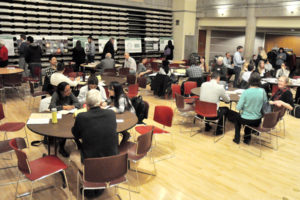
Waste diversion strategy at YMCA.
Dennis Hanagan–
Condo and apartment dwellers are slackers compared to house dwellers when it comes to sorting recyclables and food waste so the junk doesn’t go to landfill sites.
Over the past 5 to 8 years when city waste management workers have been focusing on multi-unit dwellers they’ve seen high-rise residents making a better effort to divert their waste.
But still, high-risers aren’t even close to the success shown by house dwellers. “Right now they have a 26% diversion rate compared to single-family homes who have a 66% per cent diversion rate,” Annette Synowiec, manager of Waste Management Planning, told The Bulletin.
The city’s diversion target is 70%.
“Waste reduction and diversion from landfill is important no matter where you live. You should try and make that effort,” Synowiec said.
She urges new residents in high-rises to talk to their condo board or apartment manager to learn what to do with recyclables and organic waste.
Toronto offers free recycling in-unit bags and small kitchen catchers for high-rise residents. The city also publishes recycling instructions in 17 languages to make sure all residents are informed.
Synowiec spoke to The Bulletiin in early April at the Grosvenor St. YMCA where the city held a public meeting seeking ideas and feedback on its draft Long Term Waste Management Strategy before a final version goes to city council.
Toronto is developing a plan to manage its waste, with a little as possible going to landfill, over the 30 to 50 years. It’s suggesting a 4-step strategy for individuals: reduce, reuse, recycle and recover.
At the April meeting participants were asked their opinion on a variety of issues including: what household materials would they be willing to share or borrow, how could that be done easily, what would motivate them to reduce food waste and what factors prevent high-risers from sorting their waste into general garbage, recyclables and organic waste.
There’s reason for the city’s diversion tactics, and it’s not just because landfill sites are filling up. Less food waste rotting in the ground means less gas escaping into the air and contributing to greenhouse gases.
Food waste can also be composted and used as a fertilizer to grow new food. It puts nutrients back into the soil. Some is processed into compost.
It’s much the same for recycling household junk back into new products. “It’s resources we don’t have to mine and take from the earth, and we continue to keep looping those materials through the system,” Synowiec explained.
Properly diverted waste also keeps down costs to householders. With the way Toronto’s rate structure works “the less garbage they (residents) generate the less that they pay.” In condos that savings can go back to the condo board “and they can distribute it as they feel.”
For more on the city’s waste management strategy visit toronto.ca/wastestrategy.
 TheBulletin.ca Journal of Downtown Toronto
TheBulletin.ca Journal of Downtown Toronto

